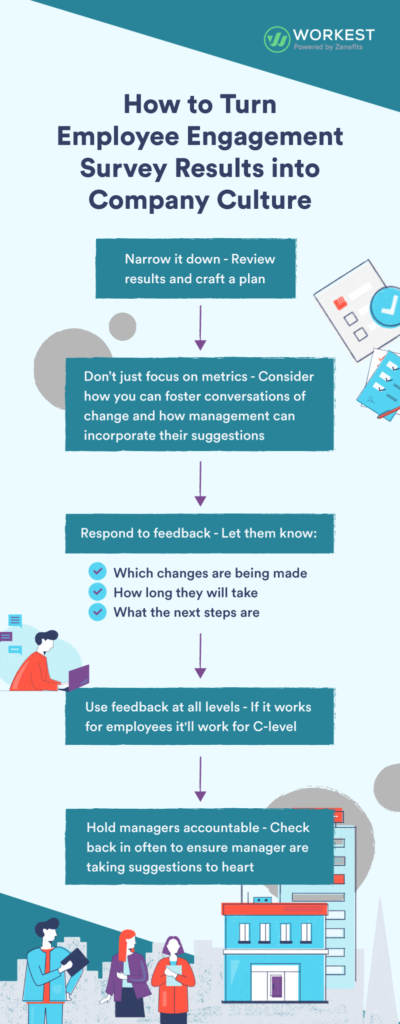Use those employee engagement survey responses to create change and build trust.

Here's what you need to know:
-
Get your employee survey results, review them, and craft a plan
-
When discussing the surveys with your execs, consider how you can foster conversations about the employee workspace and how management can incorporate their suggestions
-
Let employees know which changes are being made, how long they will take, what the next steps are
-
You should also be looking for ways to incorporate feedback at different levels of your organization
-
At the end of the day, managers are in charge of maintaining and facilitating the changes you want to make so check back often with them
You’ve worked hard to create a useful employee engagement survey and established a plan for an effective feedback loop.
But how can you turn raw data from these surveys into actionable steps?
Employees will want to see you implement these changes. You may also need to present this information better to the executive board. There are many different decision-makers and you’ll need to communicate with all of them efficiently to not slow down progress.
There’s no doubt that employee trust is important. It builds engagement, which can boost revenue and productivity. Companies with higher employee engagement are 22% more profitable than those with low engagement scores, according to data from Smarp. Further studies have shown that high employee engagement helps retention and cuts down on absenteeism.
But in order to build that engagement, you also need to handle your response to employee feedback. Here’s how you can effectively manage employee feedback while balancing company objectives and abilities.
Companies with higher employee engagement are 22% more profitable than those with low engagement scores, according to data from Smarp.
Narrow it down
The first step is to take the employee surveys, review them, and craft a plan. When you are looking to implement changes, it’s important to remember that it’s not likely that you can make many changes at once. It will help to start with any common thoughts or ideas, and then proceed through the other comments and rank them. Omit ones that will be completely impossible to implement, or make a note to attempt them at a later date.
Once you narrow down what changes you want to work on, you can begin outlining how you will go about implementing the changes.
Don’t just focus on metrics
It can be tempting to create a broad analysis of all the feedback you received and focus on positive comments. But if you look at the raw data without focusing on the thought process and interests of your employees, you’ll lose out on potential innovations and their trust.
When discussing the surveys with your executives, consider how you can foster conversations about the employee workspace itself and how management can incorporate their suggestions.
Respond to feedback
Keeping that communication feedback loop going is critical to building trust and ensuring that employees continue to provide valuable insights.
Whether you’ve decided to use specific feedback or not, it’s critical to follow up with employees so they know that you’ve actually listened to their views. Let them know:
- Which changes are being made
- How long they will take
- What the next steps are
And if you decided not to pursue a specific option, explain why, and let them know if you plan to revisit it in the future. Keeping that communication feedback loop going is critical to building trust and ensuring that employees continue to provide valuable insights.
You should also keep your team involved in the process. You may want to include them in your planning session after deciding on what you want to work on. And since it can sometimes take months before changes in policy are actually adopted, you want to make sure your employees know you haven’t forgotten about the surveys.
Use feedback at all levels
Don’t just apply feedback at one level. You should also be looking for ways to incorporate feedback at different levels of your organization. If one employee is discussing a valid point, it may work across the board.
Hold managers accountable
At the end of the day, managers are in charge of maintaining and facilitating the changes you want to make based on employee feedback. Check back often to ensure that managers are taking the suggestions to heart and are taking steps towards implementing them.










